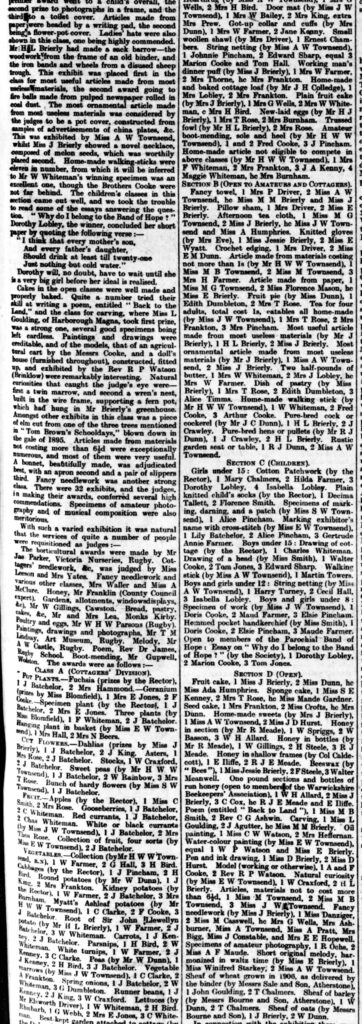The Rugby Advertiser of 18th August 1906 carried a detailed report of the third triennial King’s Newnham and Church Lawford Show. The main narrative has been transcribed below, with the reports on the various prizes shown in the original text below that.
TRIENNIAL EXHIBITION AT KINGS NEWNHAM. RECORD SHOW.
The heavy rainstorms on Wednesday last were regarded by the promoters of the flower and industrial exhibition held at Kings Newnham that day as rather unfortunate, as many who had intended patronising the holiday were, doubtless, deterred by the rain from doing so. Still, in spite of the occasional showers, hundreds of people visited the show, some of whom had journeyed a considerable distance for the purpose, and all, with one consent, agreed that it constituted a record. Numerically the entries were distinctly more gratifying than on either of the two previous occasions. In the industrial section the exhibits totalled 550, and for the flower show they numbered 350, bringing up the total to 900–200 more than the number received three years ago.
Mr J Brierly again allowed the use of the grounds at The Hall, Kings Newnham, for the purposes of the fete, and in the field adjoining two tents, one of very fair dimensions, were erected to accommodate the exhibition, which embraced quite a variety of classes. A good portion of the smaller tent was required for staging the produce from cottagers’ gardens, and considering that the classes were restricted to natives and inhabitants of Church Lawford and Kings Newnham, they were most satisfactory. Here, too, the wild flowers, grasses and fruits, entered by children, were displayed, and there can be no gainsaying the attractiveness of the collection. The winners well deserved the distinction conferred upon them. Honey was, likewise, staged in the smaller tent, and it was as good a lot as we remember seeing in the neighbourhood.
There were four well-filled classes-for sections, bottles, shallow frames, and beeswax-and, in addition, a special class was provided for members of the Warwickshire Beekeepers’ Association, and it is estimated that the aggregate weight of the produce of the hive on view was two hundredweight. The quality, too, was excellent. Amateurs’ fruit and flowers occupied the centre of the more spacious tent. Fruit was not a large show, but it was good what there was, apples being particularly fine. Pot plants were meritorious on the whole, as also were the cut flowers. The centre pieces by ladies were a pleasing feature, and for the time of the year there were one or two fine collections of roses.
The Rugby Angling Association offered prizes for collections of cut flowers. Four competed, but Mr E Daniels was easily first, his exhibit being admirably arranged, and containing quite a nice variety of garden flowers. Mr Daniels collection of vegetables, grown from Messrs Yarde’s seeds, though the only exhibit in the class, was a thoroughly good one. Unusual interest was evinced in the industrial exhibition, which contained some novel features. Cottagers’ needlework was pronounced highly creditable throughout. A few of the classes might have been better filled perhaps, but, generally speaking, the entries were satisfactory, and in some cases it was no easy matter to place the awards.
Miss A W Townsend’s prizes for string netting by children attracted a large number of youthful aspirants for honours, and in several cases excellent work had been done. No doubt some would have liked to have sampled the working man’s dinner puff. It occurred to us it would have required a fairly hungry man to have negotiated Mrs Farmer’s winning “turnover” at one sitting, though from observation of the capabilities of the male sex in this direction, we can quite believe there would be no difficulty in finding men equal to the task. Mr Fred Cooke demonstrated that he knows how to sole and heel a pair of boots decently, and among home-made articles not classified, the first prize went to a camisole, the second to preserves, the third to a knitted scarf, and the fourth to a pinafore. In the amateurs’ section competition was keen, and exceptionally neat and clever things were found.
Following some interesting classes for ladies’ fancy work, in which Mrs Driver came to the front, was one for articles made from materials costing not more than 1s. Here the premier award went to a child’s overall, the second prize to photographs in a frame, and the third to a toilet cover. Articles made from paper were headed by a writing pad, the second being a flower-pot cover. Ladies’ hats were also shown in this class, one being highly commended. Mr HL Brierly had made a sack barrow – the woodwork from the frame of an old binder, and the iron bands and wheels from a disused sheep trough. This exhibit was placed first in the class for most useful articles made from most useless materials, the second award going to fire balls made from pulped newspaper rolled in coal dust. The most ornamental article made from most useless materials was considered by the judges to be a pot cover, constructed from samples of advertisements of china plates, &c. This was exhibited by Miss A W Townsend, whilst Miss J Brierly showed a novel necklace, composed of melon seeds, which was worthily placed second.
Home-made walking-sticks were eleven in number, from which it will be inferred to Mr W Whiteman’s winning specimen was an excellent one, though the Brothers Cooke were not far behind. The children’s classes in this section came out well, and we took the trouble to read some of the essays answering the question. “Why do I belong to the Band of Hope?” Dorothy Lobley, the winner, concluded her short paper by quoting the following verse:-
“I think that every mother’s son,
And every father’s daughter,
Should drink at least till twenty-one
Just nothing but cold water.”
Dorothy will, no doubt, have to wait until she is a very big girl before her ideal is realised.
Cakes in the open classes were well made and properly baked. Quite a number tried their skill at writing a poem, entitled ” Back to the Land,” and the class for carving, where Miss L Goulding, of Harborough Magna, took first prize, was a strong one, several good specimens being left cardless. Paintings and drawings were creditable, and of the models, that of an agricultural cart by the Messrs Cooke, and a doll’s house (furnished throughout), constructed, fitted up, and exhibited by the Rev R P Watson (Brinklow) were remarkably interesting.
Natural curiosities that caught the judge’s eye were – first a twin marrow, and second a wren’s nest, built in the wire frame, supporting a fern pot, which had hung in Mr Brierly’s greenhouse. Amongst other exhibits in this class was a piece of elm cut from one of the three trees mentioned in ” Tom Brown’s Schooldays,” blown down in the gale of 1895. Articles made from materials not costing more than 6 1/2d were exceptionally numerous, and most of them were very useful. A bonnet, beautifully made, was adjudicated best, with an apron second and a pair of slippers third. Fancy needlework was another strong class. There were 32 exhibits, and the judges, in making their awards, conferred several high commendations. Specimens of amateur photography and of musical composition were also meritorious.


